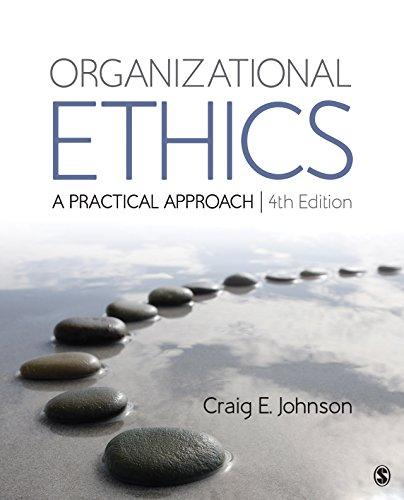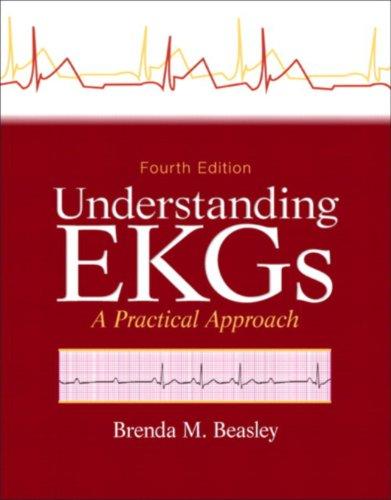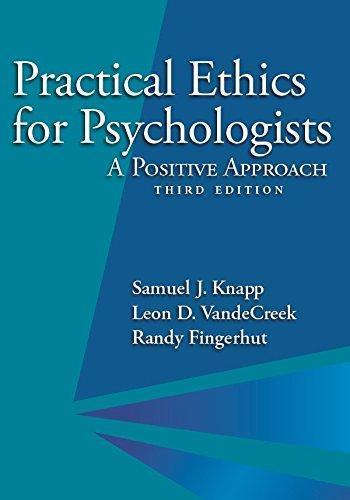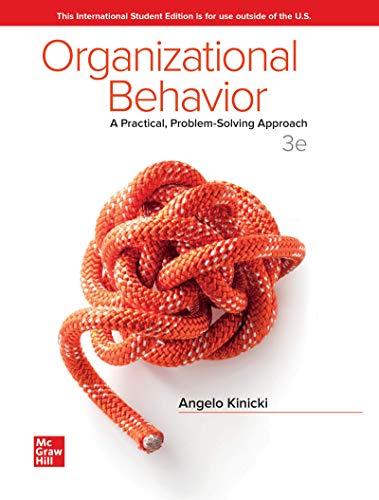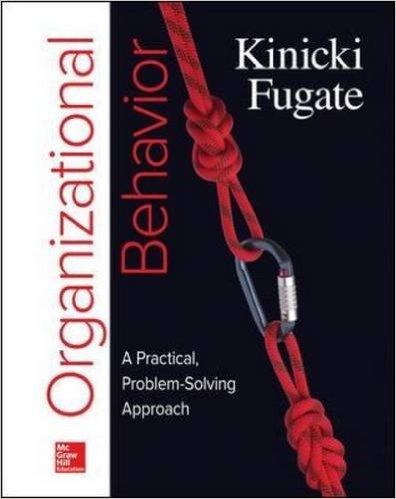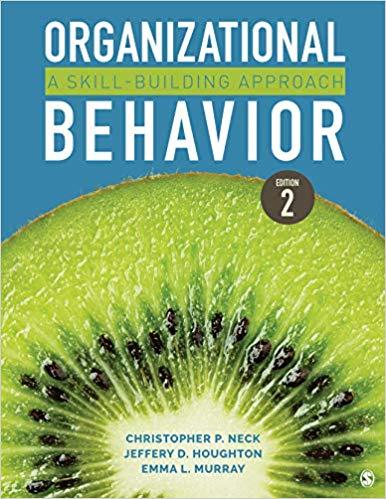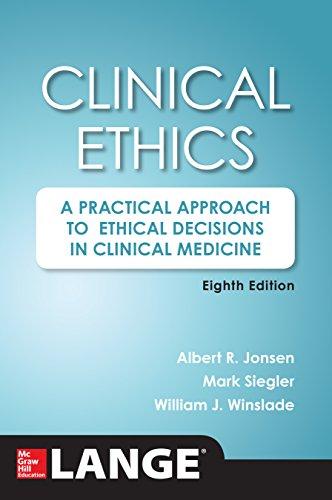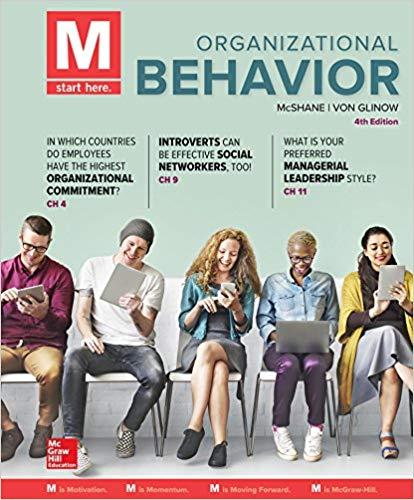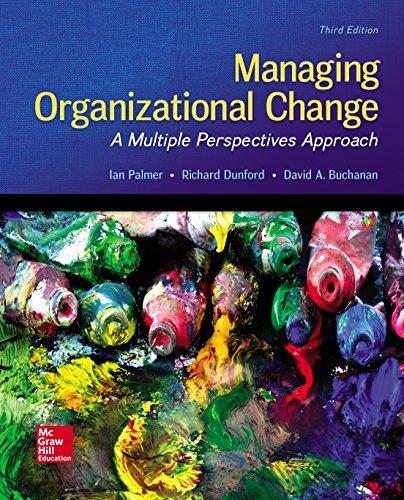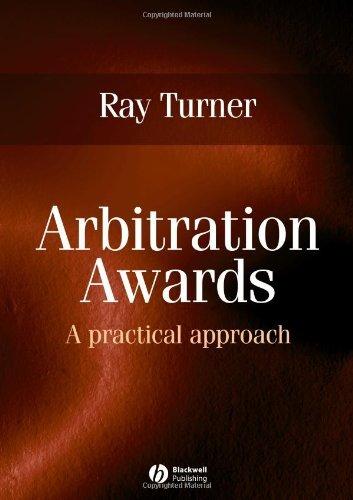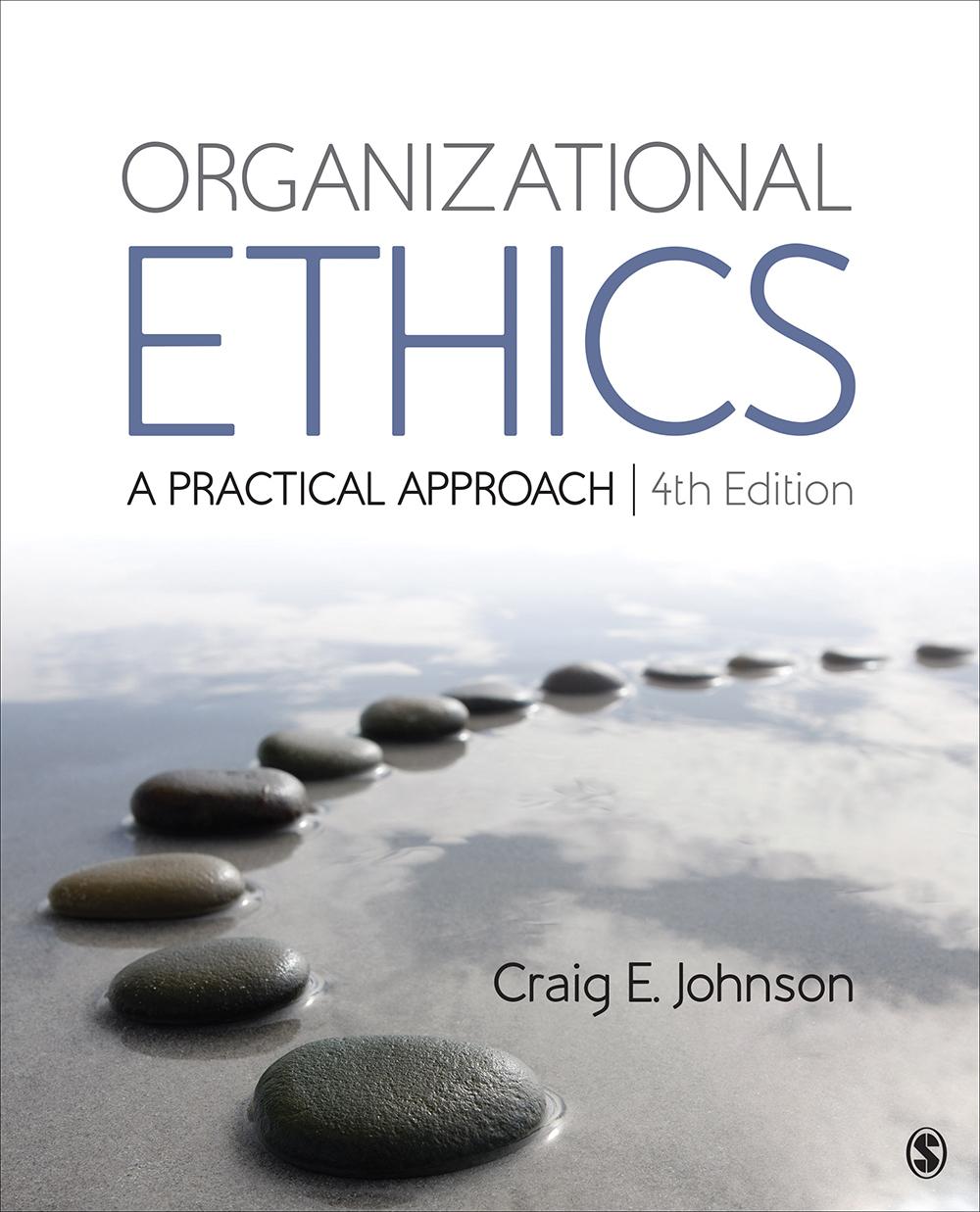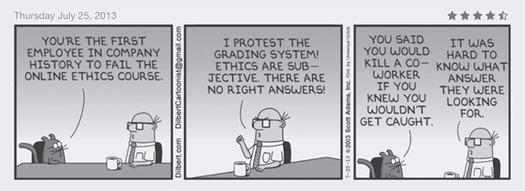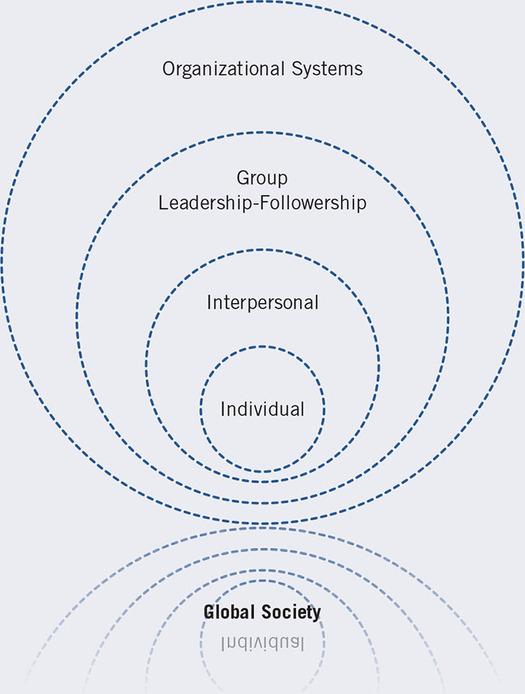Organizational Ethics: A Practical Approach 4th Edition, (Ebook PDF) Visit to download the full and correct content document: https://ebookmass.com/product/organizational-ethics-a-practical-approach-4th-edition -ebook-pdf/
More products digital (pdf, epub, mobi) instant download maybe you interests ...
Understanding EKGs: A Practical Approach 4th Edition, (Ebook PDF)
https://ebookmass.com/product/understanding-ekgs-a-practicalapproach-4th-edition-ebook-pdf/
Practical Ethics for Psychologists: A Positive Approach Third Edition – Ebook PDF Version
https://ebookmass.com/product/practical-ethics-for-psychologistsa-positive-approach-third-edition-ebook-pdf-version/
Organizational Behavior: A Practical, Problem-Solving Approach, Third Edition Angelo Kinicki
https://ebookmass.com/product/organizational-behavior-apractical-problem-solving-approach-third-edition-angelo-kinicki/
eTextbook 978-1259188411
Organizational Behavior: A Practical Problem-Solving Approach
https://ebookmass.com/product/etextbook-978-1259188411organizational-behavior-a-practical-problem-solving-approach/
(eTextbook PDF) for Organizational Behavior: A SkillBuilding Approach 2nd Edition
https://ebookmass.com/product/etextbook-pdf-for-organizationalbehavior-a-skill-building-approach-2nd-edition/
Clinical Ethics, 8th Edition: A Practical Approach to Ethical Decisions in Clinical Medicine, 8E 8th Edition, (Ebook PDF)
https://ebookmass.com/product/clinical-ethics-8th-edition-apractical-approach-to-ethical-decisions-in-clinicalmedicine-8e-8th-edition-ebook-pdf/
(eTextbook PDF) for M: Organizational Behavior 4th Edition
https://ebookmass.com/product/etextbook-pdf-for-m-organizationalbehavior-4th-edition/
Managing Organizational Change: A Multiple Perspectives Approach 3rd Edition – Ebook PDF Version
https://ebookmass.com/product/managing-organizational-change-amultiple-perspectives-approach-3rd-edition-ebook-pdf-version/
Arbitration Awards: A Practical Approach – Ebook PDF Version
https://ebookmass.com/product/arbitration-awards-a-practicalapproach-ebook-pdf-version/
DETAILEDCONTENTS List of Case Studies, Self-Assessments, Ethical Checkpoints, and Contemporary Issues in Organizational Ethics
Introduction: Making the Case for Studying Organizational Ethics
Acknowledgments
About the Author
Part one • PRACTICING PERSONAL ETHICS IN THE ORGANIZATION
Chapter 1 • Ethical Competencies and Perspectives
Developing Ethical Competencies
Defining Organizational Ethics
Ethical Perspectives
Utilitarianism: Do the Greatest Good for the Greatest Number
Kant’s Categorical Imperative: Do What’s Right Despite the Consequences
Rawls’s Justice as Fairness: Balancing Freedom and Equality
Aristotelian Ethics: Live Well
Confucianism: Building Healthy Relationships
Altruism: Concern for Others
Chapter Takeaways
Application Projects
Chapter 2 • Components of Personal Ethical Development
Component 1: Discovering Vocation
Discovering Your Personal Gifts
Barriers to Obeying Our Callings
Component 2: Identifying Personal Values
Component 3: Developing Character
Positive Psychology and Virtues
Direct Approaches to Character Development
Indirect Approaches to Character Development
Component 4: Creating a Moral Identity
Component 5: Drawing Upon Spiritual Resources
Caring for the Soul
Spiritual Well-Being
Chapter Takeaways
Application Projects
Chapter 3 • Ethical Decision Making and Action
Components of Ethical Behavior
Component 1: Moral Sensitivity (Recognition)
Component 2: Moral Judgment
Component 3: Moral Motivation
Component 4: Moral Character
Decision-Making Formats
The Lonergan/Baird Method
The Moral Compass
The Foursquare Protocol
Five Timeless Questions
The Five “I” format
Chapter Takeaways
Application Projects
Part two • PRACTICING INTERPERSONAL ETHICS IN THE ORGANIZATION
Chapter 4 • Ethical Interpersonal Communication
Dialogue: An Ethical Framework for Interpersonal
Communication
Ethical Communication Competencies
Mindfulness
Effective Listening
Self-Disclosure
Confirmation
Emotional Intelligence
Trust Building
Moral Argument
Chapter Takeaways
Application Projects
Chapter 5 • Exercising Ethical Influence
Questions of Power
Question 1: Are Some Forms of Power More Ethical Than Others?
Question 2: Is It Possible to Have Too Much Power?
Question 3: Should I Play Politics?
Question 4: What Factors Contribute to Empowerment?
Question 5: How Do I Overcome Barriers to Empowerment?
Ethical Issues in Influence
Framing
Proactive Tactics
Impression Management
Deception
Emotional Labor
Communication of Expectations
Chapter Takeaways
Application Projects
Chapter 6 • Ethical Conflict Management
Conflict in Organizational Life
Becoming an Ethical Conflict Manager
Step 1: Recognize the Differences Between Functional and Dysfunctional Conflicts
Step 2: Manage Your Emotions
Step 3: Identify Your Personal Conflict Style
Step 4: Develop Conflict Guidelines
Step 5: Employ Collaborative Conflict
Management Tactics
Step 6: Be Prepared to Apologize
Resolving Conflict Through Ethical Negotiation
Ethical Issues in Negotiation
Adopt an Integrative Approach to Negotiation
Combating Aggression and Sexual Harassment
Types of Aggression
Sources of Aggression
Resisting and Reducing Aggression
Preventing Sexual Harassment
Chapter Takeaways
Application Projects
Part three • PRACTICING LEADERSHIP, FOLLOWERSHIP, AND GROUP ETHICS
Chapter 7 • Leadership and Followership Ethics
Ethical Leadership
The Ethical Challenges of Leadership
The Shadow Side of Leadership
Stepping Out of the Shadows: Normative
Leadership Theories
Ethical Followership
The Ethical Challenges of Followership
Meeting the Moral Demands of Followership: Principles and Strategies
Chapter Takeaways
Application Projects
Chapter 8 • Improving Group Ethical Performance
Acting as a Morally Responsible Team Member
Adopting a Cooperative Orientation
Doing Your Fair Share (Not Loafing)
Displaying Openness and Supportiveness
Being Willing to Stand Alone
Responding to Ethical Danger Signs
Groupthink
Polythink
Mismanaged Agreement
Escalating Commitment
Excessive Control
Moral Exclusion
Chapter Takeaways
Application Projects
Part four • PRACTICING ETHICS IN ORGANIZATIONAL
SYSTEMS Chapter 9 • Building an Ethical Organization
Making Ethics Matter
Components of Ethical Culture
Formal Elements
Informal Elements
Cultural Change Efforts
Ethical Drivers
Chapter Takeaways
Application Projects
Chapter 10 • Ethical Marketing, Finance, Accounting, and Human Resource Management
Ethical Marketing
Ethical Issues in Marketing
Ethical Principles and Strategies
Ethical Finance and Accounting
Ethical Issues in Finance and Accounting
Ethical Principles and Strategies
Ethical Human Resource Management
Ethical Issues in Human Resource Management
Ethical Principles and Strategies
Chapter Takeaways
Application Projects
Chapter 11 • Promoting Organizational Citizenship
The Organization as Citizen Components of Organizational Citizenship
Corporate Social Responsibility
Corporate/CEO Activism
Sustainability
The Stages of Corporate Citizenship
Promoting Organizational Citizenship
Adopting a Stewardship Mind-Set
Measuring Social Performance
Chapter Takeaways
Application Projects
Chapter 12 • Ethics in a Global Society
The Dangers of Globalization and the Challenges of Ethical Diversity
Developing Cross-Cultural Ethical Competence
Coming to Grips With Ethnocentrism
Becoming a World Citizen
Understanding Ethical Diversity
Finding Moral Common Ground
Resolving Ethical Cross-Cultural Conflicts
Chapter Takeaways
Application Projects
Notes
References
Index
LIST OF CASE STUDIES, SELFASSESSMENTS, ETHICAL CHECKPOINTS, ANDCONTEMPORARY ISSUES INORGANIZATIONAL ETHICS CASE STUDIES Case Study 1.1 Federal Employees Behaving Badly 27
Case Study 1.2 National Security or Computer Security? 29
Case Study 1.3 Is This Any Way to Run a Prison? 30
Case Study 2.1 Character Development at West Point 53
Case Study 2.2 Taking Down the Monuments: Erasing History? 55
Case Study 2.3 A Different Kind of Pope 56
Case Study 3.1 White Collar Crime: The Gap Between Perpetrators and Victims 87
Case Study 3.2 Scenarios for Analysis 89
Case Study 4.1 Everyone’s Favorite Professor 117
Case Study 4.2 Unfairly Taking the Blame 118
Case Study 4.3 The Stem Cell Account 119
Case Study 5.1 Moving Beyond Empowerment at Morning Star 150
Case Study 5.2 Hiding the Real Story at Midwestern Community Action 152
Case Study 5.3 Flying the Unfriendly Skies 153
Case Study 6.1 Any Way You Look at It, You Lose: Longshore Workers versus International Container Services Inc. 183
Case Study 6.2 Negotiating the Plant Reopening 184
Case Study 6.3 When Football Comes First: Sexual Assault at Baylor University 186
Case Study 7.1 Failing to Serve Those Who Served 221
Case Study 7.2 Challenging the Chancellor 223
Case Study 7.3 Putting Fraud Before Family 225
Case Study 8.1 Team Denial 252
Case Study 8.2 Groupthink in the Sweat Lodge 254
Case Study 8.3 To Loan or Not to Loan? 256
Case Study 9.1 Winning at All Costs at Uber 288
Case Study 9.2 Wells Fargo: Getting the Ethics You Pay For 290
Case Study 9.3 GM’s Deadly Ignition Switch 292
Case Study 10.1 Boosting the Cost of the EpiPen: Price Gouging or Good Business? 321
Case Study 10.2 Accounting/Finance Ethics Scenarios 323
Case Study 10.3 Regulating Love at the Office 324
Case Study 11.1 Why the Circus No Longer Comes to Town 349
Case Study 11.2 Facebook Takes on Fake News 351
Case Study 11.3 The Public Benefit Corporation and ProfitWith-Purpose Businesses 353
Case Study 12.1 The Right to Be Forgotten 379
Case Study 12.2 Goldman Sachs and Hunger Bonds 380
Case Study 12.3 Scenarios for Analysis 382
SELF-ASSESSMENTS Self-Assessment 9.2 Socialization Scale 285
Self-Assessment 10.1 Skepticism Scale 308
Self-Assessment 10.2 Organizational Justice Scale 316
Self-Assessment 11.1 Four Stages of Issue Maturity Scale 331
Self-Assessment 11.2 Covenantal Relationship Questionnaire 344
Self-Assessment 12.1 Individualism/Collectivism Scale 362
Self-Assessment 12.2 Moral Foundations Questionnaire 369
ETHICAL CHECKPOINTS Ethical Checkpoint 1.1 Facebook Etiquette 19
Ethical Checkpoint 2.1 Character Strengths 40
Ethical Checkpoint 3.1 Rational Remedies for Cognitive Biases 70
Ethical Checkpoint 4.1 Listening Skills 101
Ethical Checkpoint 4.2 Emotional Analysis Questions 110
Ethical Checkpoint 4.3 Building Blocks of Organizational Trust 112
Ethical Checkpoint 5.1 Impression Management Tactics 137
Ethical Checkpoint 6.1 What Not to Do in a Conflict 157
Ethical Checkpoint 6.2 Five Ways to Avoid Lying During a Negotiation 167
Ethical Checkpoint 7.1 The Whistle-Blower Checklist 218
Ethical Checkpoint 8.1 Social Loafing in Virtual Teams 235
Ethical Checkpoint 9.1 Sample Mission Statements 262
Ethical Checkpoint 9.2 Integrity-Based Governance 269
Ethical Checkpoint 10.1 The Geometry of Financial Fraud 304
Ethical Checkpoint 11.1 Stakeholder Approach to CSR 334
Ethical Checkpoint 11.2 CERES Principles 338
Ethical Checkpoint 12.1 United Nations Global Compact: The Ten Principles 372
CONTEMPORARY ISSUES IN ORGANIZATIONAL ETHICS Contemporary Issues in Organizational Ethics 1.1 Extreme Altruism 24
Contemporary Issues in Organizational Ethics 2.1 The Dangers of Workplace Spirituality 49
Contemporary Issues in Organizational Ethics 3.1 Reason versus Intuition 72
Contemporary Issues in Organizational Ethics 4.1 The Trait Approach to Emotional Intelligence 108
Contemporary Issues in Organizational Ethics 5.1 “Honest” Ingratiation 140
Contemporary Issues in Organizational Ethics 6.1 Cyberbullying 175
Contemporary Issues in Organizational Ethics 7.1 Guerrilla Bureaucrats 206
Contemporary Issues in Organizational Ethics 8.1 Premature Abandonment 245
Contemporary Issues in Organizational Ethics 9.1 Cyberloafing 266
Contemporary Issues in Organizational Ethics 10.1 The Robin Hood Effect 319
Contemporary Issues in Organizational Ethics 11.1 The Rise of Consumer Boycotts 336
Contemporary Issues in Organizational Ethics 12.1 Cultural Appropriation: When Does Borrowing Become Exploitation? 358
INTRODUCTIONMAKINGTHECASEFOR STUDYINGORGANIZATIONALETHICS Evidencefortheimportanceoforganizationalethicsisallaroundus.Scarcelyaday goesbywithoutrevelationsofaneworganizationalscandal.Wereadandhearabout ethicalfailuresineverysectorofsociety—business,education,socialservice, environmental,entertainment,military,medicine,religious,government Hereisjusta smallsampleoftheprominentorganizationsaccusedofimmoralbehavior:
Figure0.1 Source: Dilbertcartoon,July25,2013
WellsFargoBank:creatingfakecustomeraccounts,mortgagefraud
GeneralMotors:failuretocorrectadefectiveignitionswitch
NationalFootballLeague:playermisconduct,includingDUIs,domesticviolence, andmurder;disregardforplayersafety
KPMG:failuretouncoverillegalsalespracticesandcorruptioninclientfirms; collusionwithgovernmentregulators
FIFA(soccer’sgoverningbody):briberyandcorruption
SterlingJewelers(KayandJaredjewelrychains):sexualharassment,gender discrimination
TrumpUniversity:deceptiveadvertising;overchargingforcourses
NationalSecurityAdministration(NSA):illegalsurveillanceofUS citizens
BaylorUniversity:sexualassaults
DeanFoods:insidertrading
St JudeMedical:shippingfaultyheartdefibrillators
Petrobras(Brazil’snationaloilcompany):bribery,moneylaundering,kickbacks
UnitedNationsHaitianpeacekeepingforce:childsexualabuseandrape
Samsung:influencepeddling
US DepartmentofVeteransAffairsmedicalsystem:falsifyingwaittimesfor patientcare
Takata:manufacturingfaultyairbags
Volkswagen:circumventingemissionstests
FoxNews:sexualharassment
Atlantaschoolsystem:falsifyingstudenttestscores
FederalBureauofAlcohol,Tobacco,FirearmsandExplosives(ATF):operatinga secretslushfund
Weallpayahighpriceforunethicalorganizationalbehavior Offendingorganizations sufferdamagedreputations;decliningrevenues,earnings,donations,andstock prices;downsizingandbankruptcy;increasedregulation;andcivillawsuitsand criminalcharges.Theirmembersmaylosetheirjobs,seetheirretirementsavings shrink,andendupdoingjailtime Outsiderswhohaveastakeorinterestinthefallen organizationalsosuffer.Forexample,patientstakingdrugswithundesirableside effectsfaceahigherriskofdeath;neighborsnearapollutingmanufacturingplant havetolivewithenvironmentaldamage;investorsvictimizedbyfraudseetheirnet worthdecline;andneedycitizensmustdowithoutimportantserviceswhentaxpayer fundsarewasted Inaddition,societyasawholesuffersbecausetrustinmanyof ourbasicinstitutionsislost.Accordingtothe2017EdelmanTrustBarometer,there hasbeenaworldwide“implosionoftrust”Intwo-thirdsofthecountriessurveyed,the “distrusters”outnumberthe“trusters,”withmorethanhalfoftherespondentssaying theydon’ttrusttheirgovernments,nongovernmentalorganizations(NGOs), businesses,andthemediatodowhatisright.1Suchlowtrustlevelsthreatenthe stabilityofcountriesaroundtheworld
Preventingsignificantharmisonereasonwhyorganizationalethicsisworthyofyour timeandattention;thefactthatyouwillconstantlybefacedwithethicalchoicesis another Asamemberofanorganization,youwillmakeethicaldecisionsonnearlya dailybasis.Someareobvious,suchaswhetherornottoclockinforacoworkerorto lietocustomers.Yetevenroutinedecisionsinvolvinghiring,accounting,planning, manufacturing,andadvertisinghaveanethicaldimension.Takethecaseofa supermarketproducebuyerdecidingwhichfruitsandvegetablestosellinherlocal stores,forinstance Shemustweighseveralethicalconsiderationswhenmaking thesedeterminations.Forexample,shouldshestockonlyorganicproducts?Should sheusesupplierswhotreattheirworkerspoorly?Shouldlocalgrowersbegiven priorityoverdistantproducersevenifthecostishigher?Ispriceorqualityamore importantconsideration?Shouldsheuseherbargainingpowertotakeadvantageof growersornegotiateagreementsthatbenefitallparties?
Notonlywillyoucontinuallymakeethicalchoices,butthosedecisionscanalso determineyoursuccessorfailureinyourcareer Technicalskillsalonearenot enoughtoguaranteeyouaproductivefuture.Forinstance,accountantsatthenow defunctArthurAndersenaccountingfirmhadalltheproperprofessionalcertifications. But,tokeeptheirclientshappyandtogenerateconsultingrevenue,theysignedoff onfraudulentfinancialstatementsatWasteManagement,theBaptistFoundationof Arizona,Sunbeam,Enron,andWorldCom Intheend,thecompany,whichwasone oftheworld’slargestandmostrespectedaccountingfirms,failed2
BusinessethicsprofessorLynnPainearguesthatmoralthinkingis“anessential capabilityforeffectivemanagersandorganizationalleaders.”3Shecontrastsmoral reasoning,whichisconcernedwithethicalprinciplesandtheconsequencesof choices,withstrategicorresults-basedthinking,whichfocusesonreaching objectivessuchasincreasingrevenue,findingnewdistributors,ormanufacturing products.Thoughdistinct,thesetwostrandsofreasoningintertwine Asamanager makingstrategicchoices,yououghttoconsiderimportantmoralprinciplesandweigh potentialethicalconsequencesoroutcomes.Ifyoudon’t,yourorganization(like ArthurAndersen)maylosetherighttooperateinamodernsociety Conversely,you mustbeagoodstrategicthinkertomakewisemoraldecisions.Youhaveto understandmarketing,production,andorganizationaldesign,forexample,to implementyourethicalchoices.
There’sonefinalreasonthatyoushouldfocusonunderstandingethicsin organizations—youhaveadutytodoso.Ibelievethatwhenweenterorganizations asmanagers,workers,orvolunteers,weassumetheethicalburdenofmakingthem betterplaces. Organizational Ethics: A Practical Approach isdesignedtohelpus carryoutthattask.Butaswetakeonthatresponsibility,weneedtoclearoutsome misunderstandingsthatserveasbarrierstoethicalchange Icallthefirstofthese myths“There’snothingtoit”Thosewhofallvictimtothismisconceptionbelievethat changingethicalperformanceiseasyorthatmakingmoralchoicesisjustcommon sense Theyareseriouslymistaken Actingmorallycanbeatoughtask,asyou’ve probablydiscoveredwhenyoutriedtodotherightthinginthefaceofpeerpressure orwerepunishedfortellingthetruth Attimesyouwillbecalledupontoputaside yourself-interesttomeettheneedsofothers,tostandalone,andtoendure criticism.Youcouldrisklosingyourjobbecauseyou“aren’tateamplayer”or becauseyouhavetobringorganizationalwrongdoingtotheattentionofoutside authorities(seeChapter7) Further,ethicaldecisionsarecomplexandoftenwithout anyclearanswers.Theymayrequirechoosingbetweenwhatappeartobetwo “rights”ortwo“wrongs.”
Thesecondmythis“Itwon’tdoanygood”Thismythcomesoutofwidespread cynicismaboutorganizationsandstandsattheoppositeendofthespectrumfrom thefirstmisconception.Accordingtothisperspective,changeistoohard,nottoo easy Theindividualcanhavelittleimpactontheethicalclimateofanorganization Organizationsaretoocomplicatedandhavealifeoftheirown Evenpeoplewithhigh personalmoralstandardsleavetheirscruplesatthedoorwhentheygotowork. Theyendupfollowingcompanydictates,nomatterhowimmoral
Thismisconceptioncontainsanelementoftruth Situationalpressuresareimportant determinantsofethicalversusunethicalbehavior Inrecognitionofthatfact,agreat dealofthistextisdevotedtohowwecanreshapetheethicalclimatesofourgroups andorganizations.Thereislittledoubtthatmanyofusdoactcontrarytoour personalconvictionsduetooutsidepressures.However,thismythoverlooksthefact thatorganizationsaretheproductsofchoices.Organizationsbecomeembroiledin scandalsbecauseindividualsandgroupsdecidetolie,steal,abusetheirpositions andpower,andcoverupcrimes.Thesamemembersthatcreateandsustain unhealthypractices,values,andstructurescandevelopmoreproductivealternatives.
Granted,yourabilitytomakesignificantsystemwidechangeswillbelimitedifyouare acollegegraduateenteringyourfirstjob Nevertheless,youdohavethepowerto manageyourownbehavior,andyourcoworkerswillnotehowyoureacttoethical issues.Yourinfluencewilllikelygrowovertime,asthosewithundergraduateand graduatedegreesgenerallyendupinmanagementpositions.
Ifyouquestiontheabilityofonepersontomakeadifference,considerthehumble originsofBarackObama HewasthesonofawhitemotherandAfricanfatherwho abandonedhisfamily.Asachild,ObamaspenttimeinbothIndonesiaandHawaii, livingeitherwithhismotherandsisterorwithhisgrandparents.Headmits experimentingwithdrugsinhighschoolashestruggledtofindhisidentity Itwasn’t untilheenrolledinlawschoolthatObamabegantoemergeasaleader,becoming theeditorandthenthefirstAfricanAmericanpresidentofthe Harvard Law Review LaterhemovedtoChicagotobecomeacommunityorganizerandteach constitutionallaw HewaselectedtotheIllinoisStateSenateandthentotheUS Senate(afterfirstbeingdefeatedbyatwo-to-onemargininaracefora congressionalseat).Fromtherehewentontobeelectedandreelectedasthefirst AfricanAmericanpresidentoftheUnitedStates.
Thethirdmythis“Toolittle,toolate.”Proponentsofthisview—includingsome universityfaculty—arguethatourethicalvaluesandstandardsaresetinchildhood Studyingethicsincollegeoronthejobisawasteoftimeifthat’sthecase Ifwe don’thavestrongvaluesbythetimeweareadults,courseworkwilldolittlegood
Researchdoesn’tsupportthisargument.Neuroscientistsreportthatbrainstructures aremalleable,whichmeansthatwecanimproveourmoralfunctioningthroughout ourlife-spans.4Psychologistshaveestablishedthatmoraldevelopment,likephysical andpsychologicaldevelopment,continuesbeyondchildhood.5Discussingethical
issuesintheclassroomdoesincreasemoralreasoningabilitiesallthewaythrough graduateschool.Mostofus,whateverourstageinlife,canpointtowaysthatour viewsonmoralissueslikethedeathpenalty,cloning,gaymarriage,stemcell research,andrecyclinghavechangedoveraperiodofyears.
Thefourthmythis“Italldepends.”Thismythsometimescomesupatthebeginning ofethicscoursesandworkshops.Oneormoreparticipantspointoutthatethical standardsdifferbetweencultures.Theyarguethatwhattheywilllearnaboutethicsin theupcomingclassortrainingsessionisoflimiteduseinaglobalsocietywherethe rightbehaviordependsontheculturalsetting Theybelievethatthereareno universalmoralstandardsandthatweshouldsetasideourparticularvaluestofitinto thelocalculture Thosewhoadoptthisstancearecorrectinnotingthatethical standardsvarybetweencultures.However,aswe’llseeinChapter12,theredo appeartobeuniversalmoralstandards.Weshouldn’tgoalongwithsomelocal practices,suchasbrideburningandfemalecircumcision Further,thereare guidelinestohelpusdeterminewhenweshouldacceptorrejectlocalcustoms.
Thefifthmythislabeled“Yesbut”Proponentsofthisviewacknowledgethatwhile ethicsisimportant,itisnotasimportantasothertopics.Theyarguethattime devotedtostudyingorganizationalethicswouldbebetterspentonothersubjects (e.g.,publicadministration,management,financing,accounting,entrepreneurship, marketing) Theyobjecttoofferingastand-aloneethicscourse Asrecentscandals indicate,however,more,notlesstime,shouldbespentonmoraldecisionmaking An EthicsResourceCentersurveyfoundthatmisconductiscommonintheworkplace. Forty-onepercentofbusinessemployeesreportedobservingunethicalconductinthe pastyear(managersweremostoftentheperpetrators),and26%saidthe misconductisongoingintheirorganizations.6Ethicsdeservesthesameattentionas, say,topicsfocusedonthebottomline.
ThesixthandfinalmythI’vetitled“Wecan’taffordit”Theargumenthereisthat adoptinghighethicalstandardsistoocostly Adherentsbelievethatethical organizationscan’tcompeteinthemodernmarketplace Groupsthatdotheright thing,likerefusingtobribeforeignofficialstogaincontracts,loseouttoless scrupulouscompetitors.Proponentsofthisviewalsopointoutthatunethicalbehavior oftengoesundetectedandthatgoodintentions,bythemselves,arenoguaranteeof organizationalsuccess.
Thereisnodoubtthatethicalbehaviorcanbecostly Unethicalbehaviorfrequently doesgounpunished,andcarefulplanningandexecutionmustbackloftygoals. However,thereisevidencethatignoringethicsiscostlierthanpursuingethics. Businessethicistsreportthat,moreoftenthannot,itpaystobeethical.Highmoral standardsandoutstandingperformanceoftengohandinhand Manyethical strategiesandactions—empoweringemployees,creatingasenseofsharedmission andvalues,demonstratingconcern,truthtelling,rewardingmoralbehavior—can improveemployeecommitmentandproductivity Theproductivityoftheentire organizationimprovesasaresult Inaddition,thereisevidencethatorganizations thatstrivetobegoodcitizensarefrequently(butnotalways)moresuccessful WinnersoftheprestigiousBaldrigePerformanceExcellenceaward,forinstance, mustdemonstrateethicalandsocialresponsibility.CompaniesadoptingtheDow JonesSustainabilityIndex(DJSI)standardsforsocialandenvironmental performancereportedahighergrossprofitmarginandhigherreturnoninvestment thansimilarnon-DJSIfirms.7
LOOKINGAHEAD Thisversionof Organizational Ethics: A Practical Approach incorporatessubstantive changesfrompreviouseditions.Materialonethicalcompetencyhasbeenmovedto Chapter1.Separatechaptersonethicalleadershipandfollowershiparecombined intoChapter7,whichnowcomesbeforethediscussionofethicalgroupperformance Anewfeaturetitled“ContemporaryIssuesinOrganizationalEthics”hasbeenadded toeverychapter.Thisboxhighlightsspecialtopics,trends,andcontroversiesinthe field Halfofthepreviouscasestudieshavebeenreplaced,andmanyofthosethat
remainhavebeenupdatedtoreflectthelatestdevelopments.Newcasesdealwith computerhacking,fakenews,Uber,theBarnumandBaileyCircus,Confederate monuments,MorningStar,WellsFargo,GoldmanSachs,Theranos,theEpiPen,the UniversityofMissouri,andBaylorUniversity Severalself-assessmentshavebeen replacedwithnewinstruments.Materialoncorporatesocialactivism,consumer boycotts,framing,redefiningthefollowershiprole,polythink,self-disclosure,universal dilemmas,andothertopicshasbeenadded
Thefourtheditionalsoretainsseveralfeaturesfoundinearliereditions.First,asthe titlesuggests,thisisabookaboutthepracticeofethicsinallsortsoforganizations (notjustbusinesses) Second,thereareplentyofopportunitiesfortheapplicationof conceptsthroughpracticalsuggestionsandchapter-endprojects.Third,thetext retainsitsinterdisciplinaryfocus.Inrecentyears,asignificantnumberofsocial scientistshavebeguntoexamineethicsintheorganizationalsetting Icitefindings fromthefieldsofmanagement,moralpsychology,education,communication, neuroscience,marketing,humanresources,organizationalbehavior,accounting, finance,andsocialpsychologyinadditiontophilosophy Thisresearchiscitedinthe notesaswellasinthecomprehensivereferencesectionattheendofthebook.
Fourth,Iemphasizeself-examinationandreflection Therearetwoself-assessments ineachchapter.Fifth,mygoalistowriteinareader-friendlystyletomakethe discussionofethicslessintimidating Sixth,Idon’thesitatetorevealmybiases.You arelikelytotakeissuewithsomeofmyconclusions.Ihopeyoudo Discussionand dialogueareessentialtothelearningprocess.
Seventh, Organizational Ethics: A Practical Approach isorganizedaroundlevelsor concentriccirclesoforganizationalbehaviorasdepictedinFigure02,startingwith theindividualandthenmovingoutward However,inpractice,theselevelsare permeable,asreflectedbythedottedlinesthatseparatethem.Eachlevelinfluences, andisinfluencedby,theotherlevels.Adishonestemployee,forexample,can undermineinterpersonalcommunication,promotedefectivegroupdecisionmaking, andhelpcreateanunethicalorganizationalculture.Conversely,acorrupt organizationcancorruptotherwisehonestgroupsandindividuals.Theorganization anditsmembersoperateinaglobalsociety Culturalvaluesandpracticesshapethe ethicalbehavioroforganizationsandthepeoplethatinhabitthem Atthesametime, organizationscanhelpreshapethevaluesofthelargersociety Eachleveliscovered separatelyinthepagestocome,butdon’tlosesightoftheirinterdependence.
PartI,“PracticingPersonalEthicsintheOrganization,”examinestheskillsand knowledgeweneedtofunctionasethicalorganizationalmembers.Manyofthe conceptsintroducedinthissectionplayanimportantroleinthelatersectionsofthe text Chapter1describesethicalcompetenciesandimportantethicalperspectives. Chapter2surveyspersonalmoraldevelopment,includingcharacterdevelopment Chapter3describesmoralreasoningandintuitionaswellasdecision-making processesandformats.PartII,“PracticingInterpersonalEthicsintheOrganization,” looksatthemoralissuesraisedbyourconnectionstootherorganizationalmembers. Chapter4outlinesanethicalframeworkforinterpersonalcommunication Chapter5 addressesquestionsofpowerandinfluenceinorganizationalsettings.Chapter6 examinesthepracticeofethicalconflictmanagementandnegotiation,providing strategiesfordealingwithaggressionandsexualharassment PartIII,“Practicing Leadership,Followership,andGroupEthics,”focusesontheethicaldilemmasthat arepartandparcelofleadershipandfollowership(Chapter7)aswellas organizationalgroupsandteams(Chapter8).PartIV,“PracticingEthicsin OrganizationalSystems,”examinesorganizationsasintegratedunits.Chapter9 looksatthecomponentsofethicalorganizationalcultureandculturalchangeefforts. Chapter10identifiesethicalissuesthatarisewhencarryingoutcriticalorganizational functions—marketing,financeandaccounting,andhumanresources.Chapter11 discussestacticsforpromotingcorporatecitizenship Chapter12addressesthe challengesofpracticingethicsinanincreasinglyglobalsociety
DIGITALRESOURCES SAGEStudySiteforInstructors
Apassword-protectedinstructorresourcesiteatedge.sagepub.com/johnson4e supportsteachingwithhighqualitycontenttohelpincreatingarichlearning environmentforstudents.TheSAGEedgesiteforthisbookincludesthefollowing instructorresources:
AMicrosoft Word testbankisavailablecontainingmultiplechoice, true/false,andessayquestionsforeachchapter Thetestbankprovidesyou withadiverserangeofpre-writtenoptionsaswellastheopportunityforediting anyquestionand/orinsertingyourownpersonalizedquestionstoeffectively assessstudents’progressandunderstanding
AnExamViewelectronictestbankisavailableandcanbeusedonPCs.The testbankcontainsmultiplechoice,true/falseandessayquestionsforeach chapterandprovidesyouwithadiverserangeofpre-writtenoptionsaswellas theopportunityforeditinganyquestionand/orinsertingyourownpersonalized questionstoeffectivelyassessstudents’progressandunderstanding ExamView isalsocompatiblewithmanypopularlearningmanagementsystemssoyoucan easilygetyourtestquestionsintoyouronlinecourse
Figure0.2
Editable,chapter-specificMicrosoft PowerPoint ¯ slidesofferyoucomplete flexibilityineasilycreatingamultimediapresentationforyourcourse.
Lecturenotessummarizekeyconceptsonachapter-by-chapterbasistohelp withpreparationforlecturesandclassdiscussions.
Samplecoursesyllabiforsemesterandquartercoursesprovidesuggested modelsforusewhencreatingthesyllabiforyourcourses.
Casenotesincludesynopses,analyses,learningobjectives,anddiscussion guidestoassistwithcase-basedteaching
Teachingstrategies,includingsuggestionsforadditionalreadings,providea jumping-offpointforcourseassignments,papers,research,groupwork,and classdiscussion
Carefullyselected,web-basedvideolinksfeaturecontentforusein independentorclassroom-basedexplorationsofkeytopics.Whenrelevant, relatedquestionsfordiscussionareincluded
Chapter-specificdiscussionquestionshelplaunchclassroominteractionby promptingstudentstoengagewiththematerialandbyreinforcingimportant content
ACKNOWLEDGMENTS Writing this text would have been impossible without assistance at every stage of the project Rob Bohall and other reference librarians helped me gather information. Students enrolled in my undergraduate and graduate business ethics classes were the first to try out cases, self-assessments, and other chapter material. Colleagues in the College of Business answered my questions on topics ranging from accounting and economics to marketing and corporate social responsibility. Colleagues around the university have given me a greater appreciation of what it means to live in an ethical community.
Several reviewers offered helpful critiques on the fourth edition of this text. These reviewers are Denise Cumberland, University of Louisville; Joe Gerard, West New England University; Glen E. Chapius, Saint Charles Community College; Laura Gow-Hogge, Eastern Oregon University; John Tichenour, Stetson University; Amy Jordan, Loyola University Chicago; Lynn Tovar, Lewis University; Joel Mackey, University of San Francisco; Robert Bass, Thomas Edison State University; Kathryn Woods, Austin Peay State University; and Pam Meyers, University of Louisiana at Lafayette. I have incorporated their insights whenever possible into this revision. The editorial and production staff at SAGE skillfully guided me through the final publication stages.
I am grateful to all the individuals and groups named above. Thanks, too, to my wife, Mary, who is all too aware of the demands that writing makes on my time but supports my efforts nonetheless.
Finally, I want to acknowledge the ethics scholars whose research and analysis provide the foundation of this book. Their ongoing efforts make me optimistic about continued progress in the study and practice of organizational ethics.
ABOUT THE AUTHOR Craig E. Johnson
(PhD, University of Denver) is professor emeritus of leadership studies at George Fox University, Newberg, Oregon, where he taught undergraduate and graduate courses in leadership, ethics, and management. During his time at the university, he served as founding director of the George Fox Doctor of Business Administration program and chair of the Department of Communication Arts. Johnson continues to teach part time in the college’s Doctor of Business Administration program and served as chair of the International Leadership Association’s Ethics Learning Community. He is the author of Meeting the Ethical Challenges of Leadership (also published by SAGE) and coauthor, with Michael Z. Hackman, of Leadership: A Communication Perspective. He has published research findings, instructional ideas, and book reviews in the Journal of Leadership Studies, the Journal of Leadership and Organizational Studies, the Journal of Leadership Education, the Academy of Management Learning and Education, the International Leadership Journal, Communication Quarterly, Communication Reports, and other journals. When not teaching or writing, he enjoys volunteering, working out, reading, fly-fishing, watching sports, and spending time with family.
PART ONE PRACTICING PERSONAL ETHICS INTHE ORGANIZATION CHAPTERONE ETHICAL COMPETENCIES ANDPERSPECTIVES CHAPTERPREVIEW Developing Ethical Competencies
Defining Organizational Ethics
Ethical Perspectives
Utilitarianism: Do the Greatest Good for the Greatest Number
Kant’s Categorical Imperative: Do What’s Right Despite the Consequences
Rawls’s Justice as Fairness: Balancing Freedom and Equality
Aristotelian Ethics: Live Well
Confucianism: Building Healthy Relationships
Altruism: Concern for Others
Chapter Takeaways
Application Projects
Before we can raise the ethical performance of ourselves and our organizations, we need to be equipped for the task. In this first section of the text we’ll focus on the knowledge and tools we need to make better ethical decisions ourselves while encouraging others to do the same. This chapter introduces ethical competencies and perspectives as well as an overview of organizational ethics. Chapter 2 addresses the components of personal moral development. Chapter 3 examines how to make and follow through on moral choices.
DEVELOPING ETHICAL COMPETENCIES For the study of organizational ethics to make a positive difference to us, to our organizations, and to society as a whole, we must put our knowledge to work. That calls for an applied or practical approach. A practical approach to organizational ethics is founded on the premise that we can develop our ethical expertise or competency just as we develop our abilities to manage, do cost accounting, and oversee operations.
University of Notre Dame psychologist Darcia Narvaez argues that we can master the knowledge and skills that can help us behave more like moral experts. She points out that ethical authorities, like experts in other fields, think differently than novices.1 First, they know more about the ethical domain. Their networks of moral knowledge are more developed and connected than those of beginners. They note commonalities and differences, are more sensitive to moral cues, and understand the moral standards of the culture and group.2 Second, they see the world differently than novices. While beginners are often overwhelmed by new data, those with expertise can quickly identify and act on the relevant information. They are able to “think about their thinking” (demonstrate metacognitive ability), knowing what moral knowledge to apply in a particular situation. Morally mature individuals also understand their personal moral standards and use their selfunderstanding to evaluate their options (e.g., “is this action consistent with my image of myself?”) Third, experts have different skill sets. They are better able to define the moral problem and then match the new dilemma with previous ethical problems they have encountered. “Unlike novices,” Narvaez says, “they know what information to access, which procedures to apply, how to apply them, and when it is appropriate.”3 As a result, they make better moral decisions faster, sometimes even automatically.
SELF-ASSESSMENT 1.1: ATTITUDES TOWARDBUSINESS (AND ORGANIZATIONAL) ETHICS INSTRUCTIONS Reflect on the following statements. Indicate your position regarding each by writing a number in the blank before each statement.
1 = Strongly disagree 2 = Disagree 3 = Not sure 4 = Agree 5 = Strongly agree
1. The only moral of business is making money.
2. Act according to the law, and you can’t go wrong morally.
3. Moral values are irrelevant to the business world.
4. The lack of public confidence in the ethics of businesspeople is not justified
5. As a consumer making an auto insurance claim, I try to get as much as possible regardless of the extent of the damage.
6. When shopping at the supermarket, it is appropriate to switch price tags on packages.
7. As an employee, I take office supplies home; it doesn’t hurt anyone.
8. I view sick days as vacation days that I deserve.
9. In my grocery store every week, I raise the price of a certain product and mark it “on sale.” There is nothing wrong with doing this.
10. The business world has its own rules.
11. True morality is first and foremost self-interested.
12. You should not consume more than you produce.
